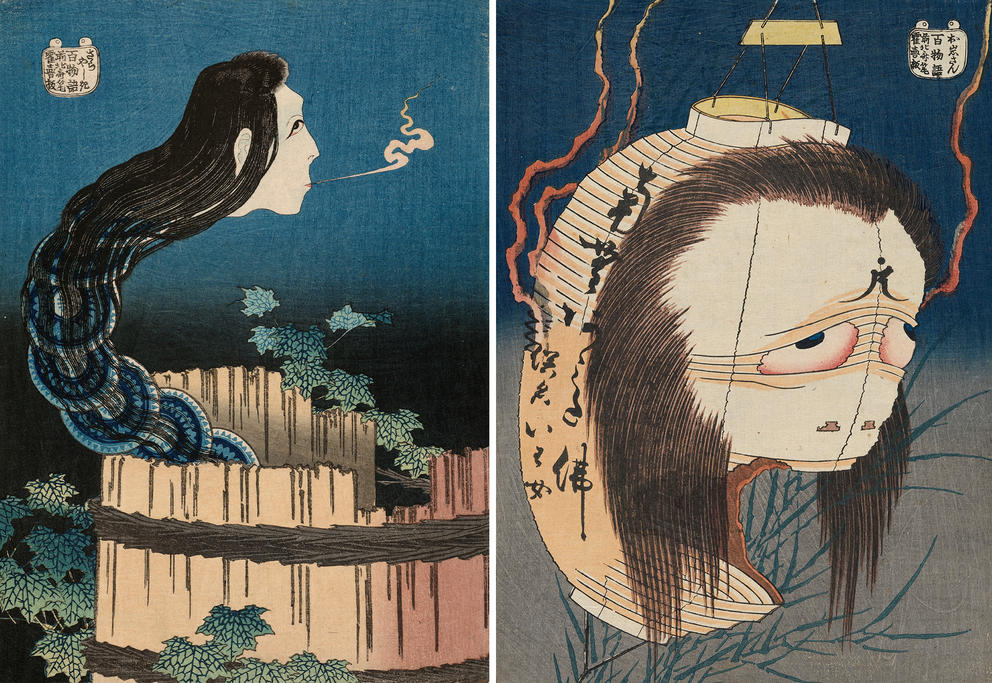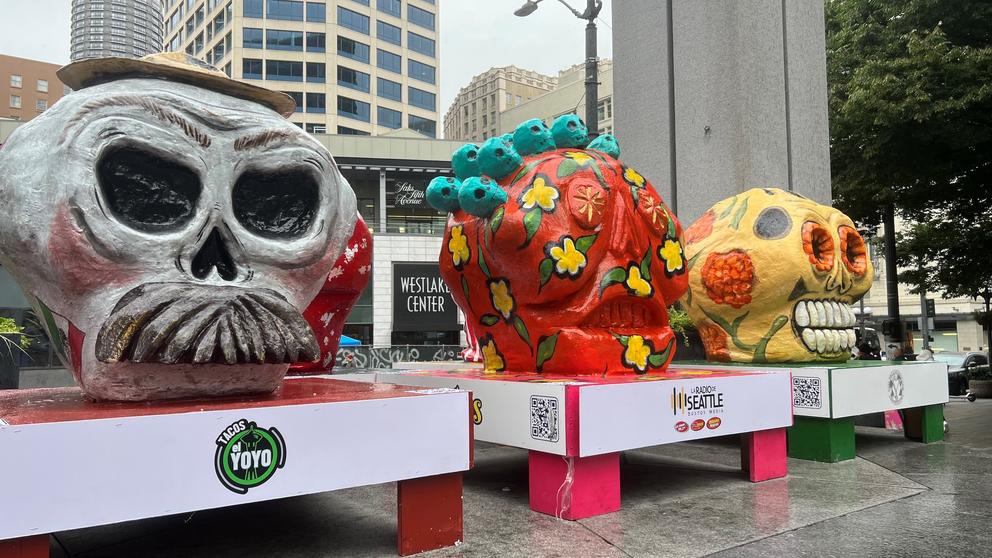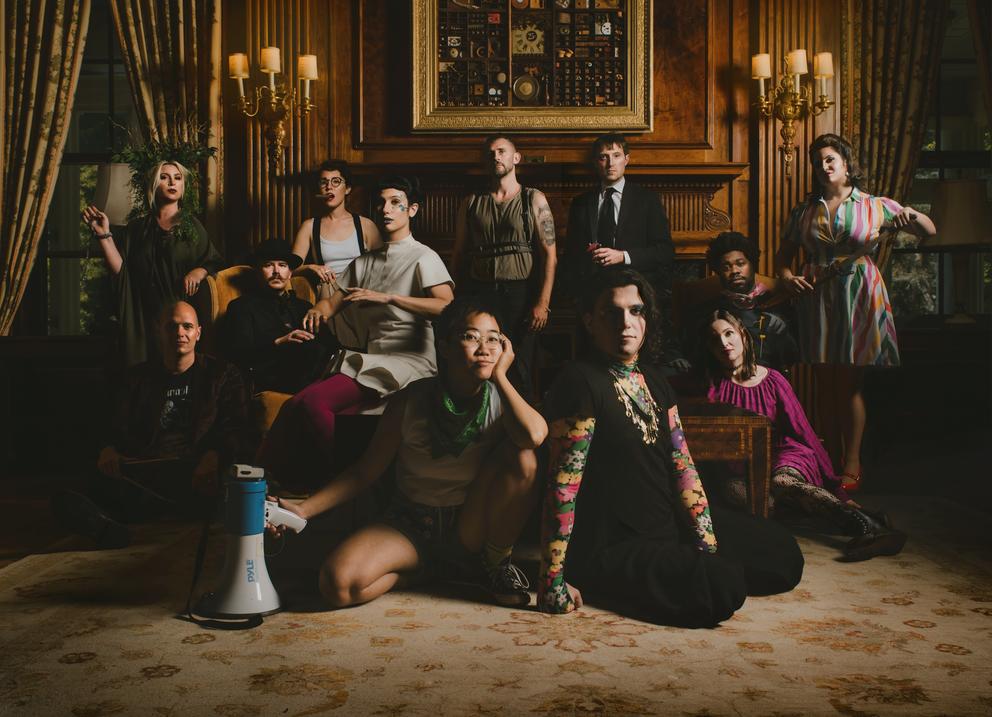Hokusai: Inspiration and Influence (through Jan. 21, 2024) showcases the work of Japanese woodblock artist Katsushika Hokusai (1760-1849), best known for his vibrant print series 36 Views of Mount Fuji — which includes the iconic “Great Wave.” On display, it’s smaller than you might expect, especially given its outsize influence. Even so, the Prussian blue crest is foreboding, poised to crash down on the small boats below.
Past these various views (Mount Fuji through a barrel! Mount Fuji behind a horse!) and toward the back of this fascinating show is a room devoted to ghosts and monsters.
Among them are five prints from Hokusai’s One Hundred Ghost Stories series, created around 1831-1832. He didn’t make it to 100 prints — maybe these five were terrifying enough?
“The Ghost of Oiwa,” based on a Kabuki play, depicts a young housewife whose husband poisoned her in order to pursue a rich neighbor’s daughter. The dead wife haunts him in the form of many objects, including a paper lantern that holds her disfigured face.
In “The Mansion of the Plates,” a woman’s head sits atop a snaking stack of dishware. This ghost was a former maidservant, who upon being accused of breaking a plate either threw herself or was thrown into a well. Each night her ghost rises to count the plates — and moans when she discovers one is missing. (Which to me sounds like a pretty apt metaphor for insomnia.)
And in a particularly creepy image, “The Ghost of Kohada Koheiji,” a ghoul uses his skeleton hands to pull down a curtain and peer into the bed of the lovers who murdered him. Scholars say Hokusai based the decomposing face on Western medical illustrations. I say, please do not peer into my dreams.
You’ll see more artful skulls in Seattle this month, including at Westlake Center, where the Downtown Seattle Association has installed a series of colorful, four-foot tall calaveras in honor of El Día de los Muertos.
Created by Mexican artist Hermes Arroyo in his hometown of San Miguel de Allende, some of the skulls are mustachioed, be-flowered or striped. One bears devil horns, another wears a tiara of mini-skulls. You can find them in Pioneer Park, Occidental Square and South Lake Union (through Oct. 31). When you do, take a moment to tip your hat to the dearly departed.
A few more stops on the spooky train include: The Hitchcock Hotel, Can Can Cabaret’s clever combo of naughty and noir (through Nov. 11); Bloodletting, Pork Filled Productions’ story of two Filipino siblings on a mission to spread their father’s ashes who encounter an aswang, or vampire (at Theatre Off Jackson through Nov. 4); and MacBeth: A Rock Musical, Seattle Public Theater’s punk rock take on the witches’ brew of murder and madness (through Nov. 5).
And now for a few upcoming events that sound scary, but aren’t:
Country Paintings with Ghosts: Seattle painter Susanna Bluhm brings her evocative oil and acrylic paintings to J. Rinehart Gallery (through Nov. 11). The abstract works are imbued with the whiff of the uncanny and uncomfortable — rendered in curious boomerangs and chalk lines.
Serpentwithfeet: The Brooklyn-based experimental musician presents Heart of Brick, a theatrical music and dance performance celebrating Black queer love, choreographed by former Seattleite Raja Feather Kelly (at The Moore Theatre, Nov. 1).
Roomful of Teeth: This mind-blowing contemporary choral group performs a mixed bill of contemporary vocal work, including a world premiere by singer/songwriter Gabriel Kahane (at Meany Center for the Performing Arts, Nov. 2).
A bouquet of books
I recently finished reading an excellent story collection that starts off with a foul smell. It permeates the house of a family mourning a dead son — some filth neglected by people too sad to worry about cleaning up the place.
“The Irates” is the first story in This Is Salvaged, the new collection by author Vauhini Vara, who grew up in Bellevue and set her last novel (The Immortal King Rao) in the Seattle region. Her short stories are full of sharp smells — a rotting egg roll, spoiled fish, spicy cooking that gets a woman chastised by her building manager. And much worse smells too.
But the odors are part of what makes Vara’s stories so vivid. Many center on women, and the particular peculiarities of close relationships among sisters and mothers and best friends.
In one, friends find companionship and competition in sketchy phone-sex work above a Chinese restaurant on Seattle’s Capitol Hill. In another, a woman with an addiction problem struggles to prove herself worthy to her sister. And in yet another, a young girl is fascinated by an old woman in her building whose wild stories about her life may or may not be true.
The situations are messy and so are the characters’ realities — there is blood and vomit, boogers and eye crust. But there’s a wealth of dark humor in the stories too, which adds to their familiarity. Vara is a true talent. She reads at Elliott Bay Books on Nov. 2.
A few more readings for your literary consideration:
Bestselling nonfiction writer and beloved classicist Mary Beard talks about her newest book, Emperor of Rome, as part of Seattle Arts and Lectures (in person at Town Hall Seattle and online, Oct. 27).
Seattle writer Alma García reads from her debut novel All That Rises (Elliott Bay Books, Nov. 1). I’m currently reading and enjoying this El Paso-set story about family secrets and all manner of borders.
And, coming back to our Halloween theme, local author Rebecca Brown reads frightful stories at The Sorrento Hotel as part of a celebration of sparkly music (featuring local theater talents Sarah Rudinoff and Chris Jeffries) and spooky literature called It’s Alive: An Evening of Monsters and Mayhem (Oct. 27).
Get the latest in local arts and culture
This weekly newsletter brings arts news and cultural events straight to your inbox.





